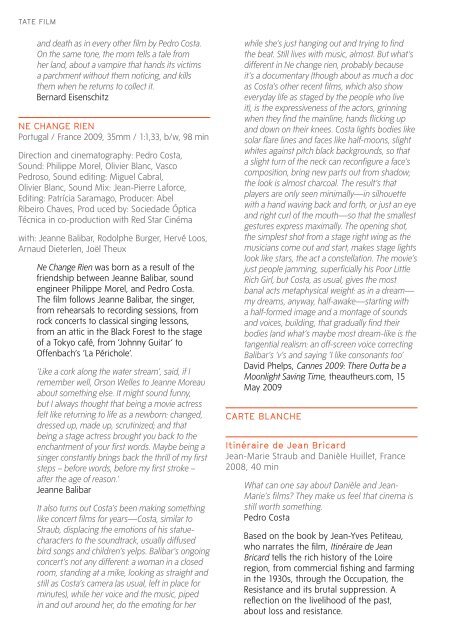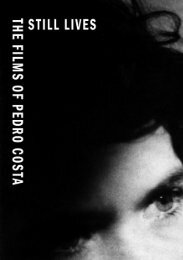Create successful ePaper yourself
Turn your PDF publications into a flip-book with our unique Google optimized e-Paper software.
<strong>TATE</strong> FILM<br />
and death as in every other film by Pedro Costa.<br />
On the same tone, the mom tells a tale from<br />
her land, about a vampire that hands its victims<br />
a parchment without them noticing, and kills<br />
them when he returns to collect it.<br />
Bernard Eisenschitz<br />
NE CHANGE RIEN<br />
Portugal / France 2009, 35mm / 1:1,33, b/w, 98 min<br />
Direction and cinematography: Pedro Costa,<br />
Sound: Philippe Morel, Olivier Blanc, Vasco<br />
Pedroso, Sound editing: Miguel Cabral,<br />
Olivier Blanc, Sound Mix: Jean-Pierre Laforce,<br />
Editing: Patrícia Saramago, Producer: Abel<br />
Ribeiro Chaves, Prod uced by: Sociedade Óptica<br />
Técnica in co-production with Red Star Cinéma<br />
with: Jeanne Balibar, Rodolphe Burger, Hervé Loos,<br />
Arnaud Dieterlen, Joël Theux<br />
Ne Change Rien was born as a result of the<br />
friendship between Jeanne Balibar, sound<br />
engineer Philippe Morel, and Pedro Costa.<br />
The film follows Jeanne Balibar, the singer,<br />
from rehearsals to recording sessions, from<br />
rock concerts to classical singing lessons,<br />
from an attic in the Black Forest to the stage<br />
of a Tokyo café, from ‘Johnny Guitar’ to<br />
Offenbach’s ‘La Périchole’.<br />
‘Like a cork along the water stream’, said, if I<br />
remember well, Orson Welles to Jeanne Moreau<br />
about something else. It might sound funny,<br />
but I always thought that being a movie actress<br />
felt like returning to life as a newborn: changed,<br />
dressed up, made up, scrutinized; and that<br />
being a stage actress brought you back to the<br />
enchantment of your first words. Maybe being a<br />
singer constantly brings back the thrill of my first<br />
steps – before words, before my first stroke –<br />
after the age of reason.’<br />
Jeanne Balibar<br />
It also turns out Costa’s been making something<br />
like concert films for years—Costa, similar to<br />
Straub, displacing the emotions of his statuecharacters<br />
to the soundtrack, usually diffused<br />
bird songs and children’s yelps. Balibar’s ongoing<br />
concert’s not any different: a woman in a closed<br />
room, standing at a mike, looking as straight and<br />
still as Costa’s camera (as usual, left in place for<br />
minutes), while her voice and the music, piped<br />
in and out around her, do the emoting for her<br />
while she’s just hanging out and trying to find<br />
the beat. Still lives with music, almost. But what’s<br />
different in Ne change rien, probably because<br />
it’s a documentary (though about as much a doc<br />
as Costa’s other recent films, which also show<br />
everyday life as staged by the people who live<br />
it), is the expressiveness of the actors, grinning<br />
when they find the mainline, hands flicking up<br />
and down on their knees. Costa lights bodies like<br />
solar flare lines and faces like half-moons, slight<br />
whites against pitch black backgrounds, so that<br />
a slight turn of the neck can reconfigure a face’s<br />
composition, bring new parts out from shadow;<br />
the look is almost charcoal. The result’s that<br />
players are only seen minimally—in silhouette<br />
with a hand waving back and forth, or just an eye<br />
and right curl of the mouth—so that the smallest<br />
gestures express maximally. The opening shot,<br />
the simplest shot from a stage right wing as the<br />
musicians come out and start, makes stage lights<br />
look like stars, the act a constellation. The movie’s<br />
just people jamming, superficially his Poor Little<br />
Rich Girl, but Costa, as usual, gives the most<br />
banal acts metaphysical weight: as in a dream—<br />
my dreams, anyway, half-awake—starting with<br />
a half-formed image and a montage of sounds<br />
and voices, building, that gradually find their<br />
bodies (and what’s maybe most dream-like is the<br />
tangential realism: an off-screen voice correcting<br />
Balibar’s ‘v’s and saying ‘I like consonants too’<br />
David Phelps, Cannes 2009: There Outta be a<br />
Moonlight Saving Time, theautheurs.com, 15<br />
May 2009<br />
CARTE BLANCHE<br />
Itinéraire de Jean Bricard<br />
Jean-Marie Straub and Danièle Huillet, France<br />
2008, 40 min<br />
What can one say about Danièle and Jean-<br />
Marie’s films? They make us feel that cinema is<br />
still worth something.<br />
Pedro Costa<br />
Based on the book by Jean-Yves Petiteau,<br />
who narrates the film, Itinéraire de Jean<br />
Bricard tells the rich history of the Loire<br />
region, from commercial fishing and farming<br />
in the 1930s, through the Occupation, the<br />
Resistance and its brutal suppression. A<br />
reflection on the livelihood of the past,<br />
about loss and resistance.<br />
<strong>PEDRO</strong> <strong>COSTA</strong><br />
Sicilia!<br />
Jean-Marie Straub and Danièle Huillet, Italy/<br />
France 1999, 66 min<br />
Jean-Marie Straub and Danièle Huillet have created<br />
a bold and beautiful adaptation of Elio Vittorini’s<br />
masterwork Conversations in Sicily. Published<br />
in 1939 and a best seller until banned in 1942,<br />
the novel narrates the return of an intellectual to<br />
his native Sicily after a long absence. The film is<br />
structured as a series of dialogue encounters—<br />
with strangers in a port, fellow passengers on a<br />
train, the protagonist’s mother—each of which<br />
conceals more than it reveals, emphasizing the<br />
distance between what can be seen and felt<br />
and what can be expressed. Moving beyond the<br />
original’s immediate context—the increasing<br />
oppression of pre-war Italy—Straub/Huillet offer<br />
a moving look at the state of permanent exile<br />
common to all of those who can’t go home again.<br />
New York Film Festival<br />
The Struggle<br />
DW Griffith, USA 1931, 84 min<br />
In these hard times, it should be an obligation: 90<br />
minutes more of DW Griffith in a film theatre equals<br />
90 minutes less of abstract crap on the screen.<br />
Pedro Costa<br />
Griffith’s brutally intense and underrated final<br />
feature, decried by critics at the time as too<br />
‘Soviet’, is a straight-up tale of alcoholism<br />
and a startling portrait of urban America<br />
during the Depression.<br />
Puissance de la Parole (The Power of Words)<br />
Jean-Luc Godard, France 1988, 25 min<br />
I remember Langlois saying that Godard and<br />
Warhol had taught us how not to make films.<br />
These two shine a light, absolutely.<br />
Pedro Costa<br />
Puissance de la parole is Godard’s elegy about<br />
the power of words, and a dialogue on the<br />
origin of creation.<br />
Beauty #2<br />
Andy Warhol, USA 1965, 66 min<br />
Beauty #2 is one of Warhol’s rarest films<br />
and a next of kin to Costa’s In Vanda’s Room.<br />
The film plants Edie Sedgwick on a bed<br />
seducing (seduced by?) Gino Piserchio, while<br />
a Doberman Pinscher named Horse uses his<br />
slack leash to appear and disappear from<br />
the frame. Off-screen, Edie’s ex-lover Chuck<br />
Wein taunts and betrays. This is performing,<br />
acting, and being as a trial – and everyone<br />
(audience, performers, director) is culpable.<br />
Le Cochon (The Pig)<br />
Jean Eustache, France 1970, 50 min<br />
Like candy in a store, like a Sunday walk in<br />
the country, like a good mystery novel, two<br />
wonderful gifts from Eustache and Gorin to<br />
enjoy and be thankful.<br />
Pedro Costa<br />
Considered by many to be Eustache’s<br />
most beautiful film, the bluntly named Le<br />
Cochon is, on the surface, an ethnographic<br />
documentary that captures a dying tradition:<br />
the slaughter and processing of a pig on<br />
a farm in the southern Massif Central. The<br />
view is detached but sympathetic: ‘With<br />
scrupulous respect for popular traditions, the<br />
film features an amazing soundtrack in which<br />
the source and originality of natural voices<br />
remains captivating, even though the thick<br />
patois and onomatopoeic accents make the<br />
actual spoken words incomprehensible.’ (Luc<br />
Moullet, Film Comment); for that reason, the<br />
film has never been subtitled. Critics have<br />
discerned in the film a critique of technology,<br />
and even religious or mythic meaning (the<br />
pig as sacrifice), its cinematic lineage pointing<br />
both back to Dreyer (La Passion de Jeanne<br />
d’Arc) and forward to Olmi’s The Tree of the<br />
Wooden Clwogs.<br />
Routine Pleasures<br />
Jean-Pierre Gorin, USA/UK/France 1986, 81 min<br />
When I saw ‘Routine Pleasures’ (on TV) I really<br />
identified with those grey routine guys whose<br />
occupation is a mini-clone of what Marx K. would<br />
call their exploitation. And what I really (note<br />
those three l’s) liked about the film was that<br />
its rhythm espouses theirs with a sympathetic<br />
camaraderie and little or no cross-cutting<br />
between painting and 3-d ‘realism’ which the<br />
first and alas last thing my Eisenstein might have<br />
thought of- or flashy bright cheery Allen Jones<br />
cuts, locos/fingertips- do you know that Charles



